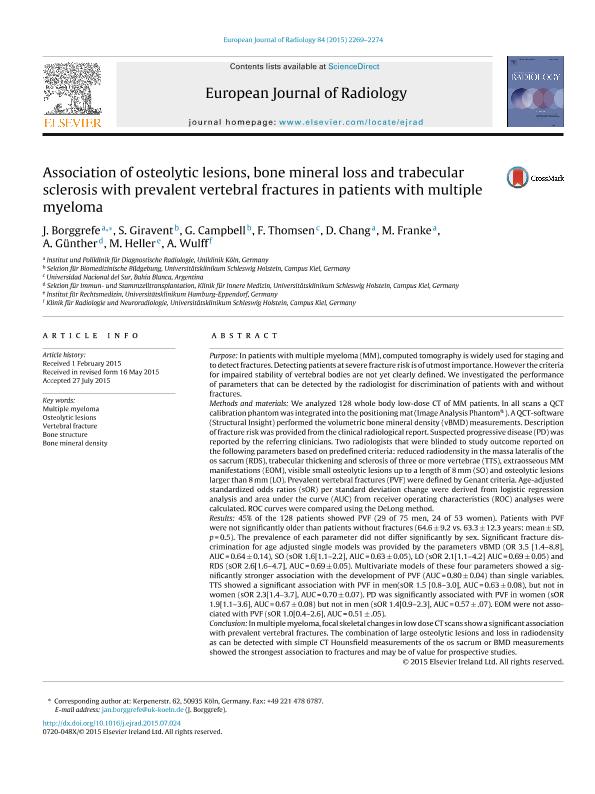Artículo
Association of osteolytic lesions, bone mineral loss and trabecular sclerosis with prevalent vertebral fractures in patients with multiple myeloma
Borggrefe, J.; Giravent, S.; Campbell, G.; Thomsen, Felix Sebastian Leo ; Chang, D.; Franke, M.; Günther, A.; Heller, M.; Wulff, A.
; Chang, D.; Franke, M.; Günther, A.; Heller, M.; Wulff, A.
 ; Chang, D.; Franke, M.; Günther, A.; Heller, M.; Wulff, A.
; Chang, D.; Franke, M.; Günther, A.; Heller, M.; Wulff, A.
Fecha de publicación:
11/2015
Editorial:
Elsevier Ireland
Revista:
European Journal Of Radiology
ISSN:
0720-048X
Idioma:
Inglés
Tipo de recurso:
Artículo publicado
Clasificación temática:
Resumen
Purpose In patients with multiple myeloma (MM), computed tomography is widely used for staging and to detect fractures. Detecting patients at severe fracture risk is of utmost importance. However the criteria for impaired stability of vertebral bodies are not yet clearly defined. We investigated the performance of parameters that can be detected by the radiologist for discrimination of patients with and without fractures. Methods and materials We analyzed 128 whole body low-dose CT of MM patients. In all scans a QCT calibration phantom was integrated into the positioning mat (Image Analysis Phantom®). A QCT-software (Structural Insight) performed the volumetric bone mineral density (vBMD) measurements. Description of fracture risk was provided from the clinical radiological report. Suspected progressive disease (PD) was reported by the referring clinicians. Two radiologists that were blinded to study outcome reported on the following parameters based on predefined criteria: reduced radiodensity in the massa lateralis of the os sacrum (RDS), trabecular thickening and sclerosis of three or more vertebrae (TTS), extraosseous MM manifestations (EOM), visible small osteolytic lesions up to a length of 8 mm (SO) and osteolytic lesions larger than 8 mm (LO). Prevalent vertebral fractures (PVF) were defined by Genant criteria. Age-adjusted standardized odds ratios (sOR) per standard deviation change were derived from logistic regression analysis and area under the curve (AUC) from receiver operating characteristics (ROC) analyses were calculated. ROC curves were compared using the DeLong method. Results 45% of the 128 patients showed PVF (29 of 75 men, 24 of 53 women). Patients with PVF were not significantly older than patients without fractures (64.6 ± 9.2 vs. 63.3 ± 12.3 years: mean ± SD, p = 0.5). The prevalence of each parameter did not differ significantly by sex. Significant fracture discrimination for age adjusted single models was provided by the parameters vBMD (OR 3.5 [1.4-8.8], AUC = 0.64 ± 0.14), SO (sOR 1.6[1.1-2.2], AUC = 0.63 ± 0.05), LO (sOR 2.1[1.1-4.2] AUC = 0.69 ± 0.05) and RDS (sOR 2.6[1.6-4.7], AUC = 0.69 ± 0.05). Multivariate models of these four parameters showed a significantly stronger association with the development of PVF (AUC = 0.80 ± 0.04) than single variables. TTS showed a significant association with PVF in men(sOR 1.5 [0.8-3.0], AUC = 0.63 ± 0.08), but not in women (sOR 2.3[1.4-3.7], AUC = 0.70 ± 0.07). PD was significantly associated with PVF in women (sOR 1.9[1.1-3.6], AUC = 0.67 ± 0.08) but not in men (sOR 1.4[0.9-2.3], AUC = 0.57 ±.07). EOM were not associated with PVF (sOR 1.0[0.4-2.6], AUC = 0.51 ±.05). Conclusion In multiple myeloma, focal skeletal changes in low dose CT scans show a significant association with prevalent vertebral fractures. The combination of large osteolytic lesions and loss in radiodensity as can be detected with simple CT Hounsfield measurements of the os sacrum or BMD measurements showed the strongest association to fractures and may be of value for prospective studies.
Archivos asociados
Licencia
Identificadores
Colecciones
Articulos(IIIE)
Articulos de INST.DE INVEST.EN ING.ELECTRICA "A.DESAGES"
Articulos de INST.DE INVEST.EN ING.ELECTRICA "A.DESAGES"
Citación
Borggrefe, J.; Giravent, S.; Campbell, G.; Thomsen, Felix Sebastian Leo; Chang, D.; et al.; Association of osteolytic lesions, bone mineral loss and trabecular sclerosis with prevalent vertebral fractures in patients with multiple myeloma; Elsevier Ireland; European Journal Of Radiology; 84; 11; 11-2015; 2269-2274
Compartir
Altmétricas



